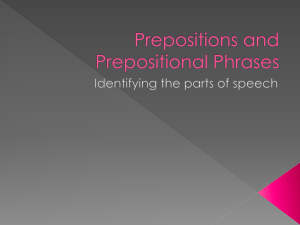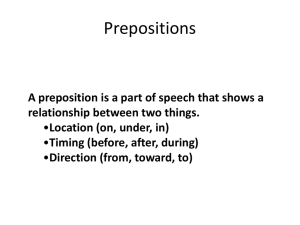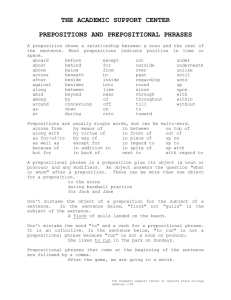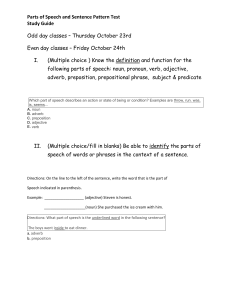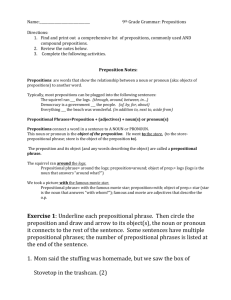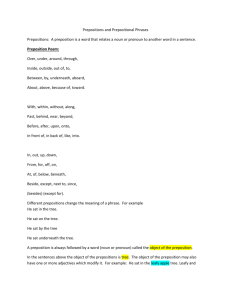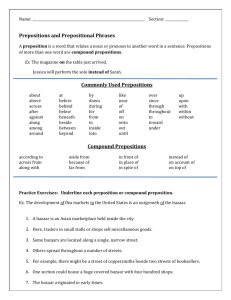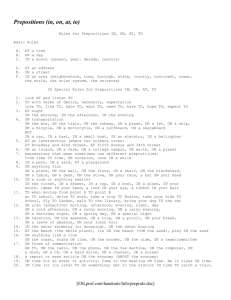Preposition Summary-MG 20110403
advertisement
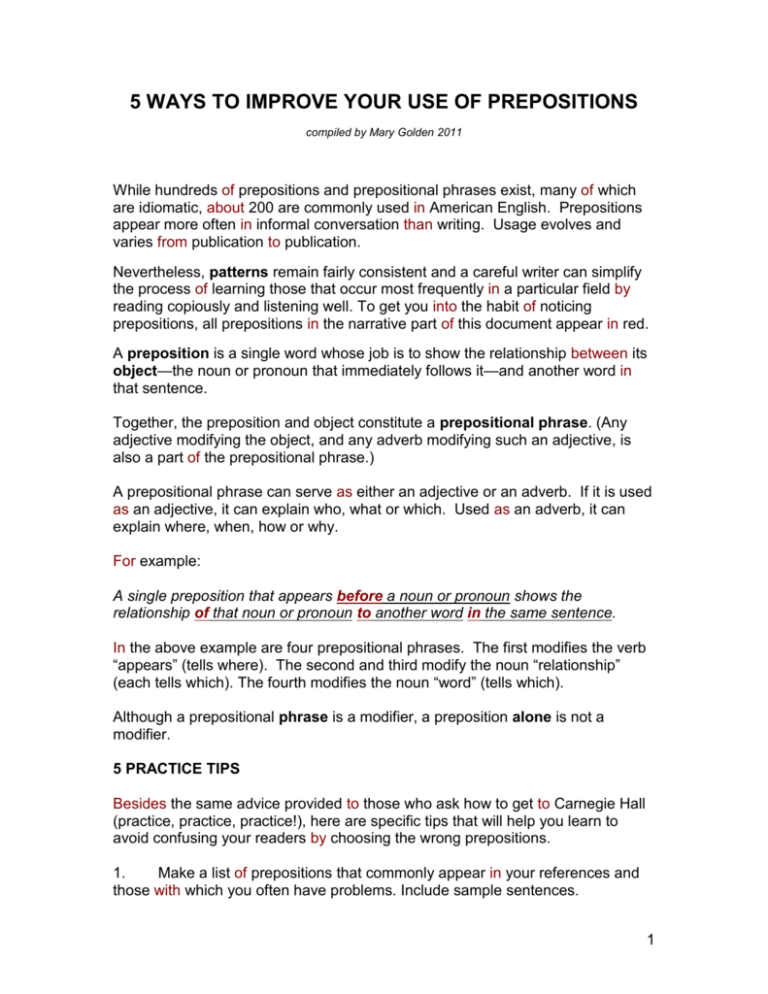
5 WAYS TO IMPROVE YOUR USE OF PREPOSITIONS compiled by Mary Golden 2011 While hundreds of prepositions and prepositional phrases exist, many of which are idiomatic, about 200 are commonly used in American English. Prepositions appear more often in informal conversation than writing. Usage evolves and varies from publication to publication. Nevertheless, patterns remain fairly consistent and a careful writer can simplify the process of learning those that occur most frequently in a particular field by reading copiously and listening well. To get you into the habit of noticing prepositions, all prepositions in the narrative part of this document appear in red. A preposition is a single word whose job is to show the relationship between its object—the noun or pronoun that immediately follows it—and another word in that sentence. Together, the preposition and object constitute a prepositional phrase. (Any adjective modifying the object, and any adverb modifying such an adjective, is also a part of the prepositional phrase.) A prepositional phrase can serve as either an adjective or an adverb. If it is used as an adjective, it can explain who, what or which. Used as an adverb, it can explain where, when, how or why. For example: A single preposition that appears before a noun or pronoun shows the relationship of that noun or pronoun to another word in the same sentence. In the above example are four prepositional phrases. The first modifies the verb “appears” (tells where). The second and third modify the noun “relationship” (each tells which). The fourth modifies the noun “word” (tells which). Although a prepositional phrase is a modifier, a preposition alone is not a modifier. 5 PRACTICE TIPS Besides the same advice provided to those who ask how to get to Carnegie Hall (practice, practice, practice!), here are specific tips that will help you learn to avoid confusing your readers by choosing the wrong prepositions. 1. Make a list of prepositions that commonly appear in your references and those with which you often have problems. Include sample sentences. 1 2. Look for patterns in lieu of rules. 3. Diagram sentences if you know how. 4. Substitute informal preposition combinations with single words, e.g.: “submit” rather than “hand in” “investigate” rather than “look into” “delay” rather than “put off” “encounter” rather than “run across” 5. From the following list of prepositions, make your own list based on those used frequently in your field. Memorize these by singing them to the tune of a song with which you are familiar. aboard about above across after against along alongside amid among around as at atop barring before behind below beneath beside besides between beyond but by circa concerning considering 2 despite down during except excepting excluding failing following for from in inside into like mid minus near notwithstanding of off on onto opposite outside over past per plus regarding round save since than 3 through throughout till to toward towards under underneath unlike until unto up upon versus via with within without worth Common Multiple Word Prepositions according to ahead of apart from as far as as to as well as aside from because of behind in by means of close to contrary to due to except for far from in accordance with in addition to in back of in case of in front of in lieu of 4 in light of in place of in regard to in regards to in spite of inside of instead of in to in view of near to next to on account of on behalf of on board on to on top of out from out of outside of owing to prior to pursuant to rather than regardless of subsequent to that of Variations of this list plus sample sentences and exercises are available on numerous websites, e.g.: http://writing.umn.edu http://www.listofprepositions.com/ http://www.paulnoll.com/Books/Clear-English/English-prepositions.html http://www.englishclub.com/grammar/prepositions-list.htm http://www.learnamericanenglishonline.com/Prepositions/Prepositions_List.html 5
